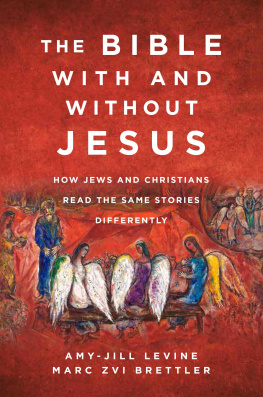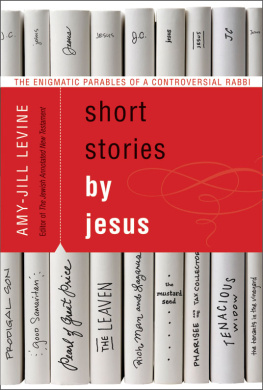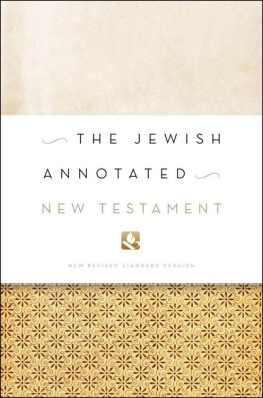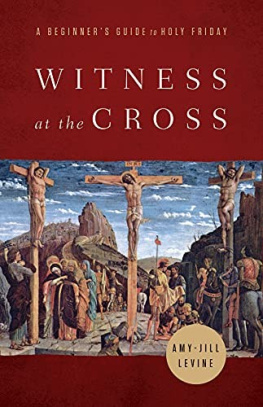Amy-Jill Levine - The Bible With and Without Jesus
Here you can read online Amy-Jill Levine - The Bible With and Without Jesus full text of the book (entire story) in english for free. Download pdf and epub, get meaning, cover and reviews about this ebook. year: 2020, publisher: HarperOne, genre: Religion. Description of the work, (preface) as well as reviews are available. Best literature library LitArk.com created for fans of good reading and offers a wide selection of genres:
Romance novel
Science fiction
Adventure
Detective
Science
History
Home and family
Prose
Art
Politics
Computer
Non-fiction
Religion
Business
Children
Humor
Choose a favorite category and find really read worthwhile books. Enjoy immersion in the world of imagination, feel the emotions of the characters or learn something new for yourself, make an fascinating discovery.
- Book:The Bible With and Without Jesus
- Author:
- Publisher:HarperOne
- Genre:
- Year:2020
- Rating:3 / 5
- Favourites:Add to favourites
- Your mark:
- 60
- 1
- 2
- 3
- 4
- 5
The Bible With and Without Jesus: summary, description and annotation
We offer to read an annotation, description, summary or preface (depends on what the author of the book "The Bible With and Without Jesus" wrote himself). If you haven't found the necessary information about the book — write in the comments, we will try to find it.
The Bible With and Without Jesus — read online for free the complete book (whole text) full work
Below is the text of the book, divided by pages. System saving the place of the last page read, allows you to conveniently read the book "The Bible With and Without Jesus" online for free, without having to search again every time where you left off. Put a bookmark, and you can go to the page where you finished reading at any time.
Font size:
Interval:
Bookmark:
In memory of our parents,
Miriam and Sidney Brettler, and Anne and Saul Levine.
The Sages taught: There are three partners in the
creation of all people: The Holy One, their father,
and their mother (b. Niddah 31a).
O UR BOOK S COVER , Marc Chagalls Abraham and the Three Angels (1966), offers readers the choice of multiple interpretations. Some may see an invocation of Genesis 18, the story of three angels or messengers who appear to Abraham and Sarah and announce that Sarah, well into menopause, will soon, miraculously, give birth to a son. For these readers, the picture may bring to mind a main theme of the Bible, expressed through the texts powerful question, Is anything too wonderful for the L ORD ? (Gen 18:14). Those aware of Jewish biblical interpretation may be reminded of the tradition of Abraham as the model of hospitality, who every day sat at the entrance of his tent in the heat of the day (Gen 18:1) to greet any passersby and to give them water and food to refresh themselves before they continued on their journey. Christian readers might focus on the meal as representing the Eucharist, or on the angels haloes, a typical depiction in Christian art, and view this painting as recalling earlier Christian depictions of this scene where the haloes indicate that these three angelic visitors are the Holy Trinity. To complicate matters more: What does it mean that the Jewish Chagall painted this scene from the Hebrew Bible using images that characterize Eastern Orthodox icons, in particular Andrei Rublevs The Old Testament Trinity?
We suggest that all of these perspectivesthe biblical, the Jewish, the Christianare important, and all are necessarily partial. The answers we receive, the interpretations we develop, are all dependent on the questions we ask, the experiences we bring, and the preferences we have.
The multiple interpretations of Chagalls picture highlight the intent of this book. Its title is not The Bible With or Without Jesus; it is The Bible With and Without Jesus. This title offers three subjects that we care about equally: Bible, with Jesus, and without Jesus. We do not claim that only one way of reading Genesis, or any other text in what is called variously the Hebrew Bible, the Tanakh, and the Old Testament, is correct. The questions we bring to the text will yield multiple answers, sometimes mutually exclusive and sometimes complementary and even mutually enhancing. We do not ask only, What did this text mean in its original contextthe time that the author of Genesis wrote the tale? Nor do we ask only, What does Genesis 18 mean in a Christian contextwith Jesus? Nor again do we focus only on the various readings of the ancient scripture in the postbiblical Jewish contextwithout Jesus. Rather, we seek to put these various interpretations into dialogue, for such dialogue helps us understand why, when we read the same text or look at the same painting, we come away with such different views. The better we can see through the eyes of our neighbors, the better able we are to be good neighbors. The more aware we are of the historical settings of the original texts, as best as we can determine them, the better we can see how the texts might have been interpreted by the ancient audience that first heard them. And the more aware we are of the historical settings of those who interpreted the biblical texts, the better we understand our own religious traditions and those of our neighbors.
This multilensed perspective comes from our teaching experience. In both our classrooms and our various programs in churches and synagogues, we have encountered individuals with limited views of their own traditions and even more limited views of interpretations in other religious communities. We have seen not only ignorance but antipathy toward the views of their neighbors. We have met many Christians who wonder about the value of the Old Testament, which they see as proclaiming an Old Testament God of wrath versus the New Testament God of love, or which they conclude is about law (seen as a negative) rather than about grace (seen as epitomizing the positive). And we have frequently encountered Jewish audiences who find the New Testament irrelevant at best, or a co-optation and even deformation of the Tanakh written by Jews for Jews. Both of these attitudes are unfortunate: ignorance of the others tradition is not bliss. We live in a multicultural society where we cannot afford to ignore the perspective of others, or indeed to perceive them as other.
We have thus teamed up, as a scholar who predominantly studies the Hebrew Bible/Old Testament/Tanakh (Brettler) and one who predominantly studies the New Testament (Levine), and who each works in reception historythe interpretation of these texts by the communities that hold them sacredto examine ten well-known passages or themes from Israels scriptures that are important to the New Testament. Each of our central chapters asks three questions: What did the text mean in its original context in ancient Israel? How do the New Testament authors interpret that text? And how do postbiblical Jews from the time of Jesus (e.g., the Dead Sea Scrolls, the first-century historian Josephus, and the first-century philosopher Philo) through the rabbinic and medieval Jewish tradition and later Christian traditions understand those same texts?
Our chapters highlight how differently different communities interpret the same material. For example, for Jews, the book of Jonah is (predominantly) about the power of repentance, and the postbiblical tradition also finds in the brief book a great amount of humor; meanwhile, for Christians it is a book (predominantly) about the resurrection of Jesus on the third day, and there is nothing funny about that. In other cases, a particular theme or text is important to one community and relatively unimportant to another. For example, Isaiahs depictions of the Servant of the L ORD , sometimes called the suffering servant, are central to Christianity, as already reflected in the New Testament, but most Jews are unaware of this image. Indeed, a number of verses that have enormous import for the New Testament and ongoing Christian theology have become virtually unknown to Jewish readers, just as Jewish interpretations (and there are usually multiple interpretations of the same verse or passage) are generally unknown to Christians. Thus this book is, in part, an act of recovery so that we can all be more familiar with biblical passages that Jews and Christians share, albeit with different emphases.
As biblical scholars, we believe that we have an obligation to provide careful explications of these texts and interpretations in a sympathetic light. Our agenda is not to show how one reading is right and another reading is wrong; it is rather to show how these interpretations developed, how they make sense given the theological presuppositions of their authors and original audiences, and how they are necessarily partial.
We also seek to demonstrate how translation matters: how reading the original Hebrew, the pre-Christian Greek translation (the Septuagint), and different English versions creates substantially different impressions. Translators, sometimes deliberately and often unconsciously, choose readings that fit the needs of their own religious communities. For example, in examining the Bibles very first story, we explain how Genesis 1:2 can be seen as speaking of both a mighty wind and the Spirit of God hovering over the deep. We see how Isaiah 7 could be speaking of a pregnant young woman, a soon-to-be-pregnant (by usual means) young woman, or a virgin who is also pregnant.
Finally, acknowledging the polemical implications of some of the Jewish and Christian interpretations, we ask of each text or theme, What might we say about them today, given our knowledge of history and theology, and given our commitment to and respect for differing traditions? With this approach, we then show how polemic can be turned to possibility.
Font size:
Interval:
Bookmark:
Similar books «The Bible With and Without Jesus»
Look at similar books to The Bible With and Without Jesus. We have selected literature similar in name and meaning in the hope of providing readers with more options to find new, interesting, not yet read works.
Discussion, reviews of the book The Bible With and Without Jesus and just readers' own opinions. Leave your comments, write what you think about the work, its meaning or the main characters. Specify what exactly you liked and what you didn't like, and why you think so.






